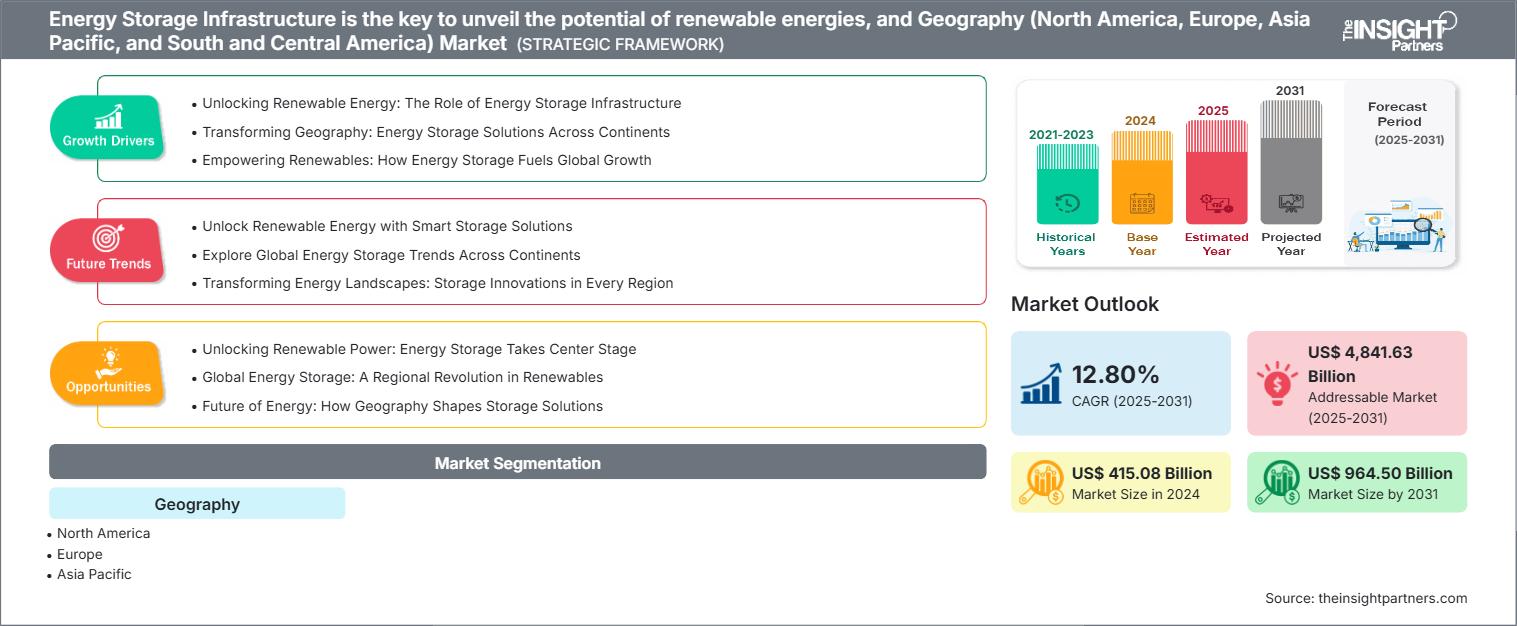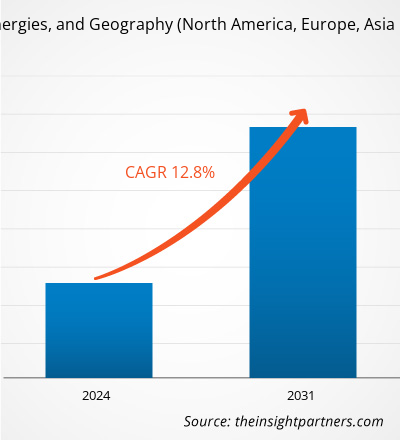エネルギー貯蔵インフラ市場は、2021年の2,563億9,000万米ドルから2031年には4,266億6,000万米ドルに達すると予測されており、 2021年から2031年にかけて6.7%のCAGRで成長すると見込まれています。容量の面では、市場は2021年の4,400メガワットから2031年には11,300メガワットに達すると予想されており、2021年から2031年にかけて12.8%という好調なCAGRを記録すると見込まれています。
エネルギー貯蔵技術の統合は、長期的には電力網のエネルギー効率に革命的な変革をもたらす可能性があります。再生可能エネルギー源による発電量の急増や、電力網のエネルギー需要の安定化に対する需要の増加といった要因は、エネルギーセクターの成長を牽引する主要な要因となるでしょう。さらに、近年のエネルギー貯蔵技術の進歩は、世界中の様々な住宅および商業施設のエンドユーザーにおける再生可能エネルギー源の導入を促進しています。その結果、エネルギー貯蔵技術とインフラ、特にバッテリー技術への投資は、主要な投資家や政府機関の間で大きな注目を集めています。
このレポートの一部、国レベルの分析、Excelデータパックなど、あらゆるレポートを無料でカスタマイズできます。また、スタートアップや大学向けのお得なオファーや割引もご利用いただけます。
エネルギー貯蔵インフラは再生可能エネルギーの可能性を明らかにする鍵であり、地域(北米、ヨーロッパ、アジア太平洋、南米、中米)市場:戦略的洞察

-
このレポートの主要な市場動向を入手してください。この無料サンプルには、市場動向から見積もりや予測に至るまでのデータ分析が含まれます。
エネルギー貯蔵インフラ市場は、過去10年間、技術の近代化、価格低下、政府の政策展開、そして貯蔵技術の研究開発投資といった面で、いくつかの注目すべき進展を経験してきました。例えば、世界で最も普及しているエネルギー貯蔵技術であるバッテリー技術の価格は、過去10年間で約80~85%まで急落しました。さらに、革新的な技術を持つ複数のスタートアップ企業が、破壊的なエネルギー貯蔵技術の可能性を秘めた有望なプロトタイプを開発しました。しかしながら、より長期間にわたるスケーラブルな貯蔵ニーズに対応するエネルギー貯蔵技術の商業化は、すべての市場プレーヤーにとって依然として課題となっています。
エネルギー貯蔵インフラ市場は、国際的に著名な複数の大手企業とニッチな新興企業で構成されています。しかし、これらの企業の総合的な能力は、主に機械、熱、電気機械、電磁気、化学といった特定の技術に集約されています。新しいエネルギー貯蔵技術の拡張性と商業的実現可能性は主要な焦点であり、それぞれの技術が個別に抱える課題にも対処する必要があります。現在、市場を席巻している主要なエネルギー貯蔵技術企業には、ABB Ltd.、Tesla、General Electric、Simmens、LG Chem、SunPowerなどが挙げられます。
COVID-19によるエネルギー貯蔵インフラ市場への影響
COVID-19パンデミックは、太陽光発電や風力発電などの産業を含む再生可能エネルギー部門のサプライチェーンと物流全体に混乱をもたらしました。他の部門とは異なり、各国の再生可能エネルギー部門は、長期にわたるロックダウン期間中、それぞれの政府からいかなる形の財政的救済や支援も受けることができませんでした。その結果、再生可能エネルギー設置現場からの需要不足により、エネルギー貯蔵技術市場も急落しました。さらに、ロックダウンの初期段階ではエネルギー需要も大幅に減少しました。COVID-19の蔓延を抑制するために政府が課した制限も、エネルギー貯蔵ソリューションの需要に深刻な悪影響を及ぼしました。さらに、製造業と工業生産の減少は、電力需要の一時的な減少をもたらしました。また、パンデミック中に多くの政府と企業が年間の再生可能エネルギー目標を達成できませんでした。そのため、多くの国と国際機関は、再生可能エネルギーの目標と目標を達成するための設定された期限を延長せざるを得ませんでした。
エネルギー貯蔵インフラ:市場洞察:
技術の進歩とコストの最適化がエネルギー貯蔵インフラ市場を活性化
エネルギー貯蔵技術は世界中で数十年以上前から存在していましたが、バッテリーがエネルギー貯蔵の一般的な選択肢として登場して以来、その人気と商業的実現可能性は飛躍的に高まりました。さらに、電気自動車の販売台数の急増は、バッテリー技術に基づくエネルギー貯蔵インフラの需要増加に大きく貢献しました。一方、先進国の公共事業体においては、電力網全体の性能と効率を向上させるためのグリッド近代化の重要性が高まっています。これを受けて、多くの国の政府は、今後数年間で優れたエネルギー貯蔵能力を確立するために、公共事業体の近代化のための特別なプログラムと資金を割り当てています。各国が今後数年間、持続可能な成長のために再生可能エネルギーの導入を進めていく中で、バッテリー技術がエネルギー貯蔵技術をリードすると予想されています。政府が提供する魅力的な財政的インセンティブと政策、そして競争力のあるバッテリー生産コストは、予測期間中、世界のエネルギー貯蔵インフラ市場への多額の投資を引き続き引き付けています。同時に、テスラ、日立、リライアンス インダストリーズなど、業界をリードする多くの市場プレーヤーが、大規模なエネルギー貯蔵ソリューションの開発に多額の投資を行っています。
エネルギー貯蔵インフラは再生可能エネルギーの可能性を明らかにする鍵であり、地域(北米、ヨーロッパ、アジア太平洋、南米、中米)市場地域分析
エネルギー貯蔵インフラは再生可能エネルギーの潜在能力を明らかにする鍵であり、予測期間全体を通して地域別(北米、ヨーロッパ、アジア太平洋、中南米)市場に影響を与える地域動向と要因について、The Insight Partnersのアナリストが徹底的に解説しています。このセクションでは、エネルギー貯蔵インフラは再生可能エネルギーの潜在能力を明らかにする鍵であり、地域別(北米、ヨーロッパ、アジア太平洋、中南米)市場セグメントと北米、ヨーロッパ、アジア太平洋、中東・アフリカ、中南米の地域についても説明します。
エネルギー貯蔵インフラは再生可能エネルギーの可能性を明らかにする鍵であり、地域(北米、ヨーロッパ、アジア太平洋、南米、中米)市場レポートの範囲
| レポート属性 | 詳細 |
|---|---|
| 2024年の市場規模 | 4,150.8億米ドル |
| 2031年までの市場規模 | 9,645億米ドル |
| 世界のCAGR(2025年~2031年) | 12.80% |
| 履歴データ | 2021-2023 |
| 予測期間 | 2025~2031年 |
| 対象地域と国 |
北米
|
| 市場リーダーと主要企業の概要 |
|
エネルギー貯蔵インフラは再生可能エネルギーの可能性を明らかにする鍵であり、地理(北米、ヨーロッパ、アジア太平洋、南米、中米)市場プレーヤーの密度:ビジネスダイナミクスへの影響を理解する
エネルギー貯蔵インフラは、再生可能エネルギーの可能性を最大限に引き出す鍵であり、地域別(北米、ヨーロッパ、アジア太平洋、中南米)市場は、消費者の嗜好の変化、技術の進歩、製品の利点に対する認識の高まりといった要因によるエンドユーザーの需要増加に牽引され、急速に成長しています。需要の増加に伴い、企業は提供内容を拡大し、消費者ニーズを満たすために革新を起こし、新たなトレンドを活用しており、これが市場の成長をさらに促進しています。

- エネルギー貯蔵インフラは再生可能エネルギーの可能性を明らかにする鍵であり、地理(北米、ヨーロッパ、アジア太平洋、南米、中米)市場のトップキープレーヤーの概要
ストレージ技術に基づく市場分析
世界のエネルギー貯蔵インフラ市場は、種類別に機械式、電気機械式、化学式、その他に分類されます。その他には、電磁式および熱式エネルギー貯蔵技術が含まれます。エネルギー貯蔵インフラ市場は、主に水圧ポンプ式機械技術が主流ですが、バッテリーベースの電気機械技術は、過去10年間で投資家からかつてないほどの注目を集めています。さらに、電気自動車の人気の高まりにより、先進国および発展途上国において、バッテリーベースのエネルギー貯蔵インフラソリューションに対する需要がさらに高まっています。
エネルギー貯蔵インフラ市場で事業を展開する企業は、合併、買収、市場開拓といった戦略を採用し、市場における地位を維持しています。主要企業による動向をいくつかご紹介します。
- 2022年1月、カナダのエネルギー企業であるHydrostor Inc.は、今後数年間で米国とオーストラリア全土に優れた圧縮空気エネルギー貯蔵施設を開発するために、大手投資会社であるゴールドマン・サックスから最大2億5,000万米ドルの資金を受け取りました。
- 2021年10月、米国政府はリチウム電池サプライチェーンの強化を目指し、エネルギー貯蔵を基盤とした研究への資金提供計画を発表しました。この研究は、電気自動車用バッテリーの供給確保と既存のエネルギー貯蔵インフラの効率向上に焦点を当てています。米国エネルギー省はまた、国内のリチウム電池サプライチェーンにおけるギャップを最小化するための官民パートナーシップの構築計画も発表しました。
エネルギー貯蔵インフラ市場は、貯蔵技術と地域に基づいて分割されています。貯蔵技術に基づいて、市場は機械式、電気機械式、化学式、その他に分類されます。地域別に見ると、エネルギー貯蔵インフラ市場は、北米(米国、カナダ)、欧州(英国、ドイツ、フランス)、アジア(中国、日本、インド)、中東(サウジアラビア、UAE)、その他地域の5つの主要地域に分割されています。容量の面では、中央政府による再生可能エネルギーの導入奨励への多額の投資を受けて、中国は2022~2031年の間、エネルギー貯蔵インフラ市場を引き続き支配すると予想されています。競争上のポジショニングの面では、いくつかの大手テクノロジー企業と革新的なニッチな新興企業が、それぞれのビジネス提供によって、世界のエネルギー貯蔵インフラ市場を支配し続けています。レポートでは、これらの企業の業績と主要な開発状況を簡単に概説しています。エネルギー貯蔵インフラ市場調査で紹介されている企業には、ABB Ltd、Tesla Inc.、LG Chem Ltd.、Hitachi Energy Ltd.などがあります。東芝インフラシステムズ株式会社、パナソニック株式会社、BYD株式会社、サムスンSDI株式会社、EcoFLow、Sonnen GmbH。
- 過去2年間の分析、基準年、CAGRによる予測(7年間)
- PEST分析とSWOT分析
- 市場規模価値/数量 - 世界、地域、国
- 業界と競争環境
- Excel データセット
最新レポート
お客様の声
購入理由
- 情報に基づいた意思決定
- 市場動向の理解
- 競合分析
- 顧客インサイト
- 市場予測
- リスク軽減
- 戦略計画
- 投資の正当性
- 新興市場の特定
- マーケティング戦略の強化
- 業務効率の向上
- 規制動向への対応






















 無料サンプルを入手 - エネルギー貯蔵インフラは再生可能エネルギーの可能性を明らかにする鍵であり、地理(北米、ヨーロッパ、アジア太平洋、南米、中米)
無料サンプルを入手 - エネルギー貯蔵インフラは再生可能エネルギーの可能性を明らかにする鍵であり、地理(北米、ヨーロッパ、アジア太平洋、南米、中米)